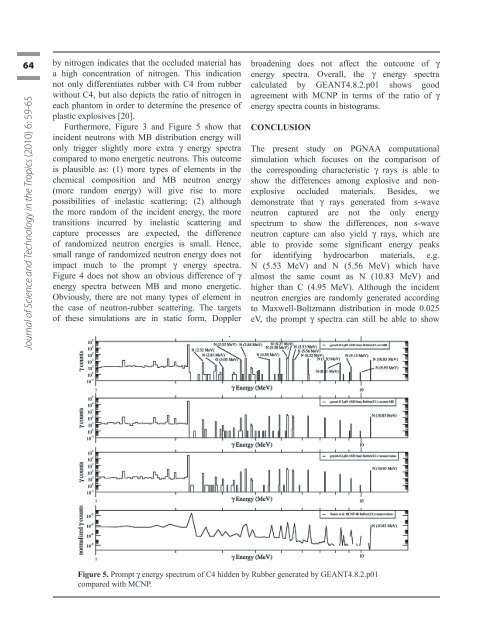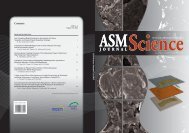Download - Akademi Sains Malaysia
Download - Akademi Sains Malaysia
Download - Akademi Sains Malaysia
Create successful ePaper yourself
Turn your PDF publications into a flip-book with our unique Google optimized e-Paper software.
64<br />
Journal of Science and Technology in the Tropics (2010) 6: 59-65<br />
by nitrogen indicates that the occluded material has<br />
a high concentration of nitrogen. This indication<br />
not only differentiates rubber with C4 from rubber<br />
without C4, but also depicts the ratio of nitrogen in<br />
each phantom in order to determine the presence of<br />
plastic explosives [20].<br />
Furthermore, Figure 3 and Figure 5 show that<br />
incident neutrons with MB distribution energy will<br />
only trigger slightly more extra γ energy spectra<br />
compared to mono energetic neutrons. This outcome<br />
is plausible as: (1) more types of elements in the<br />
chemical composition and MB neutron energy<br />
(more random energy) will give rise to more<br />
possibilities of inelastic scattering; (2) although<br />
the more random of the incident energy, the more<br />
transitions incurred by inelastic scattering and<br />
capture processes are expected, the difference<br />
of randomized neutron energies is small. Hence,<br />
small range of randomized neutron energy does not<br />
impact much to the prompt γ energy spectra.<br />
Figure 4 does not show an obvious difference of γ<br />
energy spectra between MB and mono energetic.<br />
Obviously, there are not many types of element in<br />
the case of neutron-rubber scattering. The targets<br />
of these simulations are in static form, Doppler<br />
broadening does not affect the outcome of γ<br />
energy spectra. Overall, the γ energy spectra<br />
calculated by GEANT4.8.2.p01 shows good<br />
agreement with MCNP in terms of the ratio of γ<br />
energy spectra counts in histograms.<br />
CONCLUSION<br />
The present study on PGNAA computational<br />
simulation which focuses on the comparison of<br />
the corresponding characteristic γ rays is able to<br />
show the differences among explosive and nonexplosive<br />
occluded materials. Besides, we<br />
demonstrate that γ rays generated from s-wave<br />
neutron captured are not the only energy<br />
spectrum to show the differences, non s-wave<br />
neutron capture can also yield γ rays, which are<br />
able to provide some significant energy peaks<br />
for identifying hydrocarbon materials, e.g.<br />
N (5.53 MeV) and N (5.56 MeV) which have<br />
almost the same count as N (10.83 MeV) and<br />
higher than C (4.95 MeV). Although the incident<br />
neutron energies are randomly generated according<br />
to Maxwell-Boltzmann distribution in mode 0.025<br />
eV, the prompt γ spectra can still be able to show<br />
Figure 5. Prompt γ energy spectrum of C4 hidden by Rubber generated by GEANT4.8.2.p01<br />
compared with MCNP.<br />
Jostt vol 6.indd 64 7/22/10 10:10:31 PM<br />

















